
Carbohydrate Metabolism (The Living Cell)
Explain why glucose is stored as glycogen in the liver and muscle Describe the important steps in the synthesis and degradation of glycogen Describe the role and importance of glucose-6-phosphate as a key metabolic intermediate Describe the role of the pentose phosphate pathway in the synthesis of fatty acids Describe the role and importance of gluconeogenesis in the maintenance of blood glucose
-
Outline of what this flashcard set covers (in red)
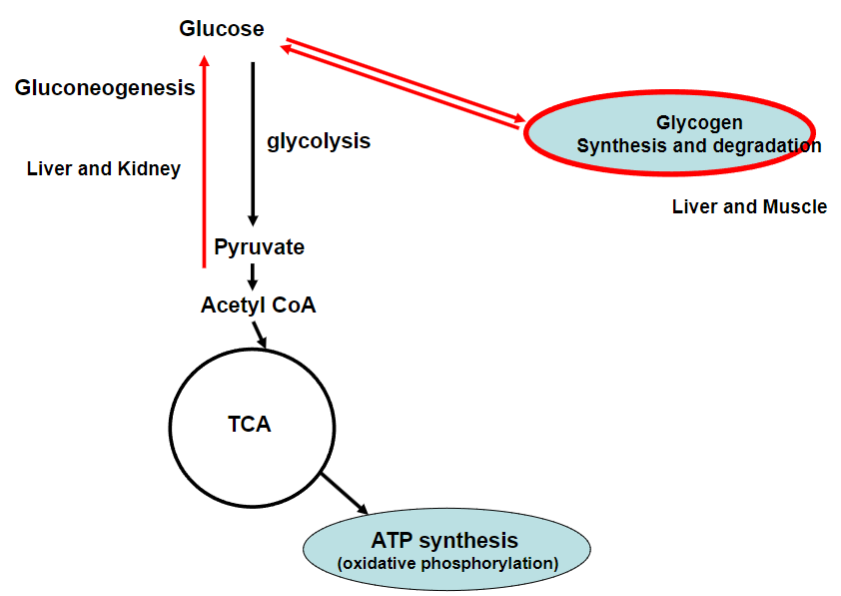
-
What is Hypoglycaemia?
Low blood glucose levels
-
What is Hyperglycaemia?
High blood glucose levels
-
What are the symptoms of Hypoglycaemia? (8)
Shakiness or tremors
Sweating
Irritability or mood changes
Loss of coordination
Rapid heartbeat
Blurred vision
Weakness or fatigue
Severe cases may lead to Hypoglycaemic coma and death
-
What are the symptoms of Hyperglycaemia? (8)
Increased thirst (polydipsia)
Frequent urination (polyuria)
Fatigue
Blurred vision
Slow wound healing
Increased hunger (polyphagia)
Non-enzymatic modification of proteins
Severe cases may lead to Hyperosmolar coma
-
What is the value when blood glucose is considered critically low?
2.5mM
-
Picture overview of the processes that occur in the Liver
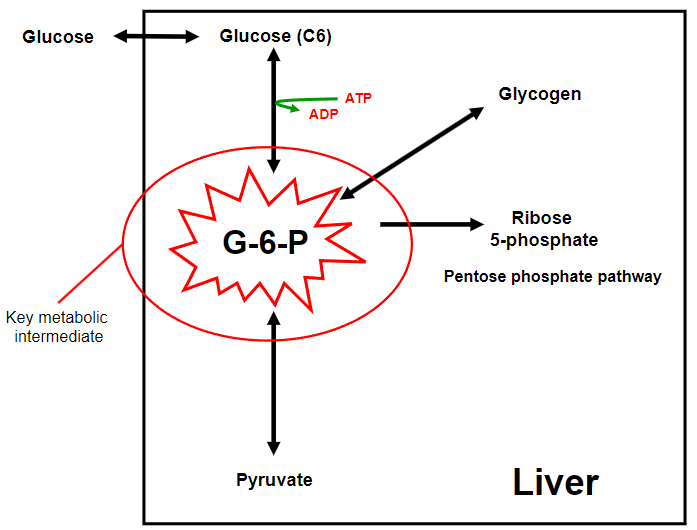
-
Where does glycogenesis take place?
-Liver (100g)
-skeletal muscle (300-400g)
-
When does glycogenesis take place?
When blood glucose levels are high
-
Why does glycogenesis take place?
Glycogen is a safe way to store glucose
-
What regulates glycogen synthesis?
Insulin
-
What bonds does glycogen have?
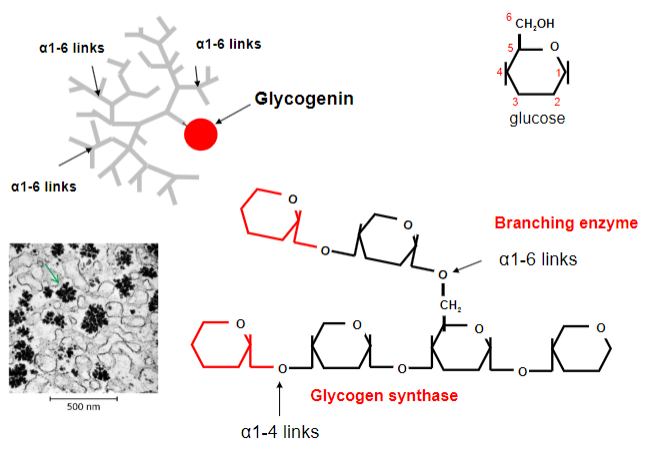
-alpha-1,4-glycosidic bonds
-alpha-1,6-glycosidic bonds
-
Outline the steps of glycogen synthesis:
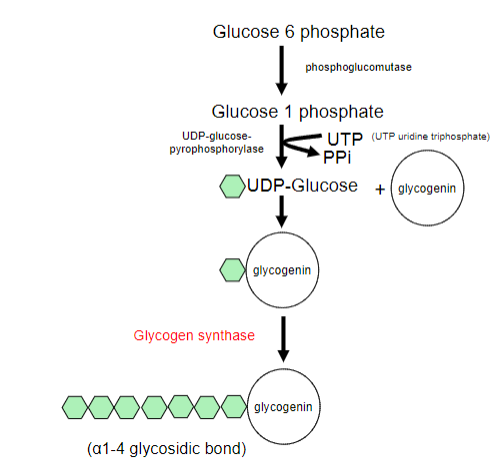
-
What does the branching enzyme do in glycogen synthesis?
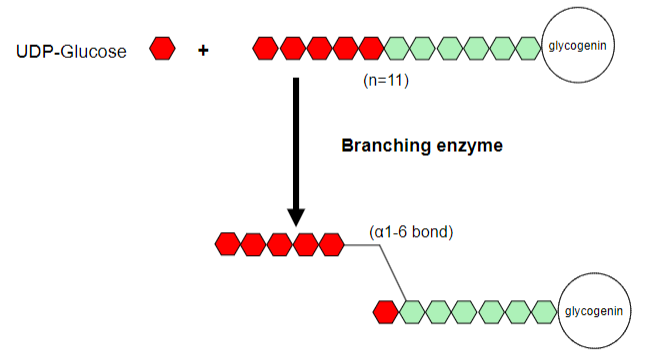
-The branching enzyme transfers a segment of the growing chain and attaches it to an earlier part of the chain
-Forming an alpha-1,6-glycosidic bond
-
Why does the body store glucose in the form of glycogen? (3)
• Cannot store glucose as it is osmotically active
• 400mM glucose is stored as 0.01μM glycogen, so storage efficient
• The branched structure of glycogen means it can be rapidly mobilised
-
Glycogen synthesis requires a protein primer called what?
Glycogenin
-
Glucose is activated by the reaction with...?
UTP (Uridine triphosphate)
-
What enzyme forms the alpha 1-4 glycosidic bonds?
Glycogen synthase
-
What are the FOUR things that stimulate glycogenolysis (breakdown)?
-Glucagon
-Adrenalin
-Noradrenaline
-Growth hormone
-
Picture outlining the steps in glycogen breakdown:
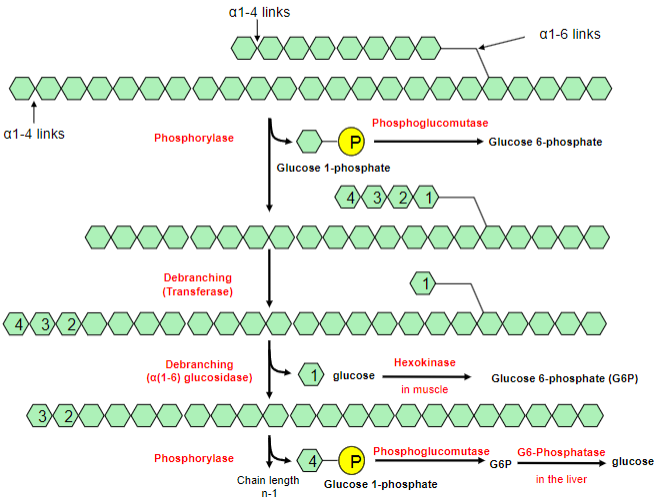
-
Glycogenolysis yields two products, what are they?
-Glucose 1-phosphate
-Glucose
-
Three enzymes are required for glycogenolysis; What are these enzymes?
-Phosphorylase
-Transferase
-Debranching enzyme
-
What does phosphorylase do in glycogenolysis?
Breaks the a1-4 links
-
What does transferase do in glycogenolysis?
Moves 3 glucose residues to an existing chain
-
What does Debranching enzyme a1-6 do in glycogenolysis?
Hydrolyses the remaining alpha-1,6-glycosidic bond at the branch point
-
Phosphoglucomutase converts what into what?
Converts G1P to G6P
-
Glucose 6 phosphatase converts G6P to glucose in the liver and kidney, but not in...?
Muscle
-
What is Glycogen Phosphorylase? Role?
An enzyme involved in glycogenolysis, the breakdown of glycogen into glucose
-
How is Glycogen Phosphorylase regulated?
• By allosteric interactions that signal the energy state of the cell
• Also by reversible phosphorylation regulated by hormones such as insulin, glucagon, adrenalin and noradrenalin
• Regulation of glycogen phosphorylase differs in muscle and liver
-
What converts Glycogen phosphorylase b (inactive) to Glycogen phosphorylase a (active)?
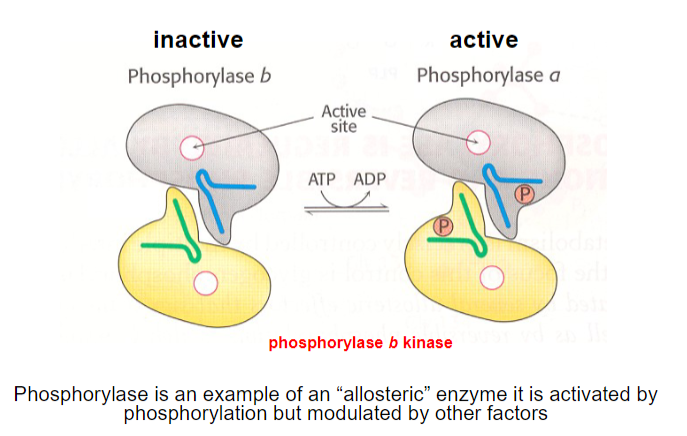
Phosphorylase b kinase
-
Outline the steps in the conversion of Glycogen phosphorylase b (inactive) to Glycogen phosphorylase a (active)?
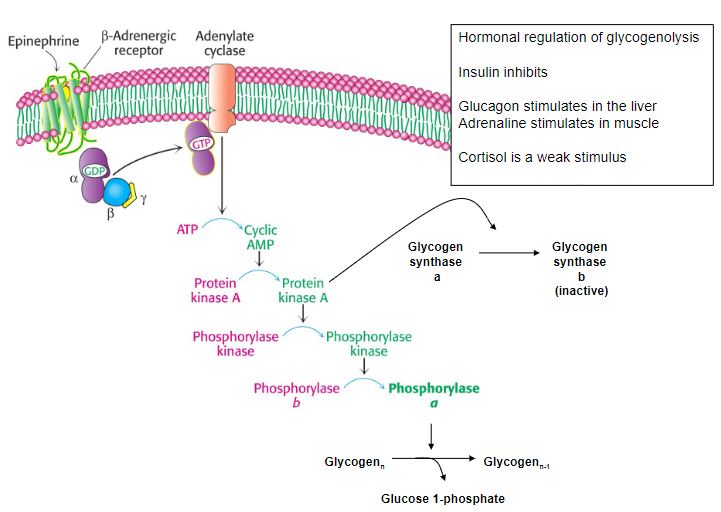
-
When does 5'-AMP form?
When ATP is depleted
-
In muscle, glycogen phosphorylase b can be activated by 5'-AMP without undergoing what?
Phosphorylation
-
5'-AMP is a good indicator of what?
Low ATP energy levels
-
ATP, which is abundant when energy levels are sufficient, competes with 5'-AMP for the same binding site on glycogen phosphorylase. When ATP binds what is prevented?
Prevents unnecessary glycogen breakdown when energy stores are adequate.
-
In the liver, glycogen phosphorylase exists in what form?
Phosphorylase a
-
When glucose is generated due to ATP, glucose inhbits a molecule; What is this molecule? Why?
-Activated phosphorylase kinase a in the liver
-Feedback inhibition prevents excessive glycogen breakdown when glucose levels are sufficient
-
Ca2+ ions activate what?
Phosphorylase b kinase
-In muscle, mediating glycogenolysis during muscle contraction
-
In the liver, a-adrenergic activation stimulates what?
Ca2+ release
-
When is Glycogen synthase activated and what is it stimulated by?
-Activated in times of plenty of glucose
-Stimulated by Insulin
-
When is Glycogen phosphorylase activated and what is it stimulated by?
-Activated when blood glucose is low
-Stimulated by Glucagon, Adrenaline and noradrenaline
-
What specific molecules activate and inactivate Glycogen synthase? (3)
– Activated by ATP and G6P
– Inactivated by phosphorylation (by protein kinase A)
– Activated by dephosphorylation (by protein phosphatase-1)
-
What specific molecules activate and inactivate Glycogen phosphorylase?
– Inactivated by ATP and G6P
– Activated by phosphorylation (by phosphorylase b kinase
– Inactivated by dephosphorylation (by protein phosphatase-1)
-
Outline the steps in the Pentose Phosphate Pathway:

-
What is Gluconeogenesis?
A metabolic pathway that involves the synthesis of glucose from non-carbohydrate precursors.
-
Where does Gluconeogenesis take place?
-60% in the liver
-40% in the kidney
-Small amount in the intestine
-
When does Gluconeogenesis take place?
-When blood glucose levels are low fasting, starvation
-
Outline the steps of gluconeogenesis: (HINT: Kind of the reverse of glycolysis)
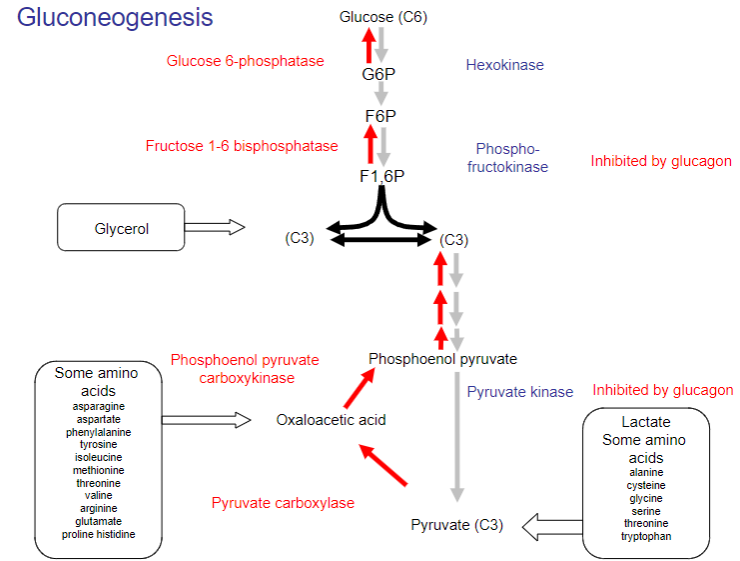
-
Outline the steps of gluconeogenesis at the membrane of cells (diagram answer)
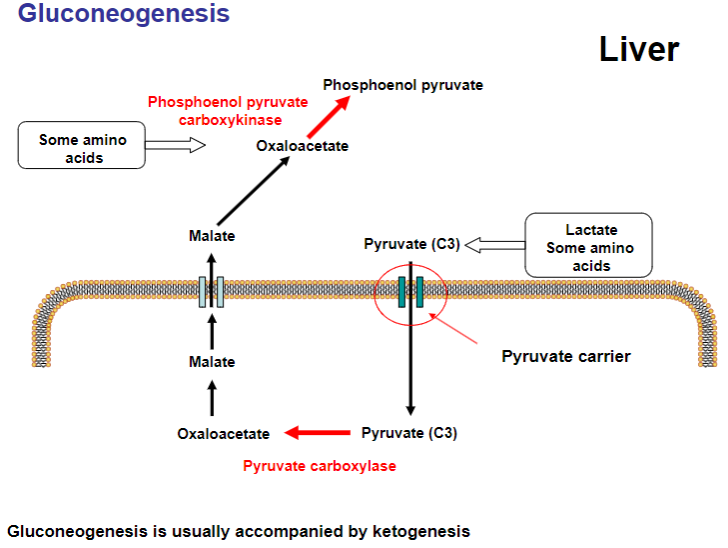
-
Three most important substrates for gluconeogenesis are what?
-Amino acid (alanine)
-Lactate
-Glycerol (from triglycerides)
-
What is the daily requirement of glucose in the body? How much does your brain need?
-Daily requirement is 160g
-The brain needs 120g
-
What is the total body reserves of glucose at any given time?
210g
-
<p>What does phosphorylase b kinase do?</p><p>Specifically, phosphorylase b kinase phosphorylates and activates glycogen phosphorylase</p>

